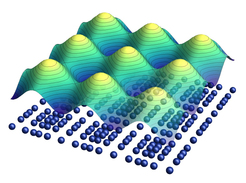Constructive conflict in the superconductor
22 Aug 2012
Charge density waves improve our understanding of the zero-resistance transport of electricity and could explain an unusual interplay of superconducting and magnetic materials.
 Whether a material conducts electricity without losses is not least a question of the right temperature. In future it may be possible to make a more reliable prediction for high-temperature superconductors. These materials lose their resistance if they are cooled with liquid nitrogen, which is relatively easy to handle. An international team, in which physicists of the Max Planck Institute for Solid State Research in Stuttgart played a crucial role, has now discovered that this form of superconductivity competes with charge density waves, i.e. with a periodically fluctuating distribution of the charges. Since the physicists did not previously take account of this competition in their models, their calculations of the transition temperature, where superconductivity sets in, remained inaccurate. In further work, the researchers at the Stuttgart Max Planck Institute have gained insights into how superconducting materials interact with magnetic ones. They observed that the electronic properties affect crystal vibrations to a greater extent than was to be expected. This effect could help to control material properties such as superconductivity or thermoelectricity.
Whether a material conducts electricity without losses is not least a question of the right temperature. In future it may be possible to make a more reliable prediction for high-temperature superconductors. These materials lose their resistance if they are cooled with liquid nitrogen, which is relatively easy to handle. An international team, in which physicists of the Max Planck Institute for Solid State Research in Stuttgart played a crucial role, has now discovered that this form of superconductivity competes with charge density waves, i.e. with a periodically fluctuating distribution of the charges. Since the physicists did not previously take account of this competition in their models, their calculations of the transition temperature, where superconductivity sets in, remained inaccurate. In further work, the researchers at the Stuttgart Max Planck Institute have gained insights into how superconducting materials interact with magnetic ones. They observed that the electronic properties affect crystal vibrations to a greater extent than was to be expected. This effect could help to control material properties such as superconductivity or thermoelectricity.
If electricity from high-power offshore wind farms or even large-scale solar parks in the Sahara is to be distributed to consumers in Germany in future, quite a bit of energy will be lost in the long power lines. Superconducting cables could prevent this if cooling them does not consume more energy than they help to save. Bernhard Keimer and his colleagues at the Max Planck Institute for Solid State Research in Stuttgart want to identify materials that deserve the name high-temperature superconductor both in practical terms and also in terms of our usual perception of temperature. To do this they first have to understand how superconductivity works in these materials and how it can be influenced; these materials are known as high-temperature superconductors, even though they lose their resistance at temperatures which make a Siberian winter seem almost mild. The Stuttgart-based physicists have now taken a further step down this road in two current publications.
According to one of their discoveries we can probably consider ourselves lucky that high-temperature superconductivity - a property which remains promising despite its present disadvantages - exists at all. ''It is obviously down to a fortunate coincidence,'' says Bernhard Keimer, Director at the Stuttgart Max Planck Institute. This is at least suggested by the observations of the international team that includes not only Bernhard Keimer and his colleagues, but also scientists at the Politecnico di Milano, the European Synchrotron Radiation Facility Grenoble, the University of British Columbia in Canada and further research institutions.
Superconductivity beats the charge density waves in a close competition
The researchers discovered that the superconductivity in one type of copper oxide ceramic competes with a state in which a charge density wave forms. Physicists have known about such charge density waves for decades from two-dimensional materials such as the niobium selenides, for example. Here, the conduction electrons do not distribute uniformly across the crystal like in a metal. On the contrary, they form a regular pattern of regions in which they concentrate to a greater or lesser extent.
''We did not expect the charge density waves in the superconducting cuprates, because they destroy the superconductivity,'' says Bernhard Keimer. Instead of concentrating at regular intervals to a greater or lesser extent, the electrons in superconductors join up to form Cooper pairs which can slip through a crystal with zero resistance. Accordingly, the researchers observed the charge patterns only above the transition temperature, the temperature at which the material becomes superconducting.






























